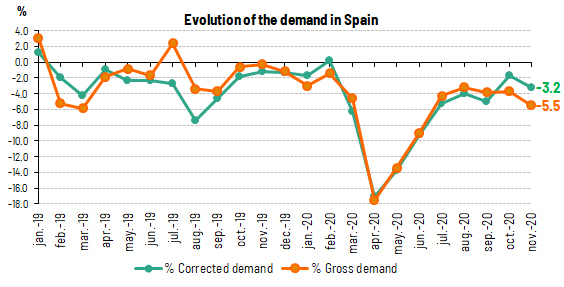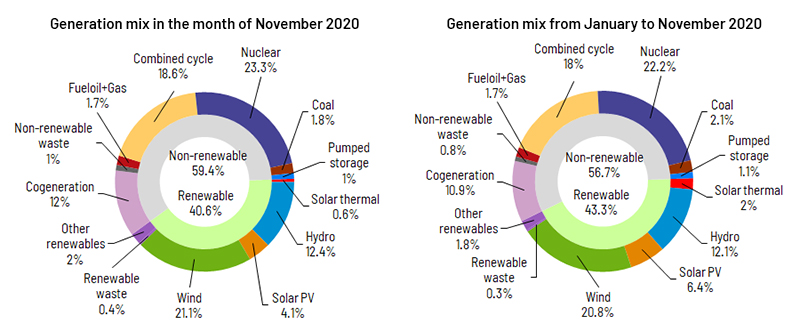Discover what Red Eléctrica is, what we do, and why we are the backbone of the electricity system in Spain and the ecological transition.
Demand for electricity in Spain falls by 5.5% in November
- 40.6% of monthly generation came from renewable sources and 64.9% was produced from technologies that do not emit CO2 emissions.
- Demand for electricity in the Balearic Islands fell by 11.7% and in the Canary Islands by 9.8% compared to November 2019.
National electricity demand in November is estimated at 20,797 GWh, 5.5% lower than in the same month last year. After having factored in the influence of seasonal and working patterns, demand is 3.2% lower than that registered in the November 2019, as this year the temperatures during November have been noticeably warmer.

In the first eleven months of 2020, demand is estimated at 227,551 GWh, 6.2% less than in 2019. After having factored in the influence of seasonal and working patterns, this figure fell 6%.
In November, and according to data estimated at the time of this press release, generation coming from renewable energy sources represented 40.6% of the total production. So far this year, renewable generation has produced 13.4% more than in the same period in 2019. Therefore, from January to November 2020, renewable generation reached a share of 43.3% of the total electricity generated nationwide.
Additionally, 64.9% of electricity generation during November was obtained using technologies which produce zero CO2 emissions.
With information available as at the time of this press release, wind energy generation in November reached 4,208 GWh, a figure that is 43.6% lower than in the same period last year, and represented 21.1% of production nationwide, ranking as the second technology in the generation mix, behind nuclear (23.3%) and followed by combined cycle (18.6%)

Demand for electrical energy in the peninsular electricity system falls 5.2%
Demand for electrical energy in the peninsular electricity system in the month of November is estimated at 19,738 GWh, a value 5.2% lower than that recorded in the same month last year. After having factored in the influence of seasonal and working patterns, the demand for electricity is 2.9% lower than that registered in November 2019.
In the first eleven months of 2020, the demand for electricity on the Spanish Peninsula is estimated at 215,383 GWh, a figure that is 5.7% lower than in 2019. In this case, after having factored in the influence of seasonal and working patterns, demand is 5.5% lower than in the same period of the previous year.
During November, and according to data estimated at the time of this press release, 42.2% of peninsular generation came from renewable energy sources and 67.7% was obtained using technologies which produce zero CO2 emissions. For its part, wind energy stood at 4,150 GWh, 43.4% less than in November last year, and became the second-placed technology by contributing 21.8% to the overall generation mix.
Demand for electricity in November decreased 11.7% in the Balearic Islands and 9.8% in the Canary Islands
In the Balearic Islands, the demand for electricity in November is estimated at 364,292 MWh, a value that is 11.7% lower than that registered in the same month last year. After having factored in the influence of seasonal and working patterns, the figure decreased by 7.5% with respect to November 2019. In the first eleven months of 2020, demand in the Balearic Islands is estimated at 4,504,348 MWh, 20.9% less than in the same period in 2019.
Combined cycle, with 70.8% of the total generation, was the leading source of electricity generation in the Balearic Islands in the month of November, a month in which renewable technologies and those which produce zero CO2 emissions accounted for 7.2% of the total generation in the archipelago.
Regarding the Canary Islands, electricity demand is estimated at 662,381 MWh, 9.8% down on that registered in the same month last year. After having factored in the influence of seasonal and working patterns, the figure drops by 10.1% with respect to November 2019. In the first eleven months of 2020, demand in the Canary Islands is estimated at 7,290,048 MWh, a decrease of 10.3% on the same period in 2019.
In November, combined cycle, with 45.7% of the total, was the leading source of electricity generation on the Canary Islands. Renewable technologies and those which produce zero CO2 emissions accounted for 11.3% of the total generation on the Canary Islands.
Consult our Daily Balance Report for more information on the National, Peninsular, Balearic Islands and Canary Islands electricity systems as at the close of November.











